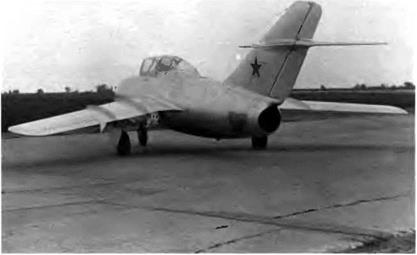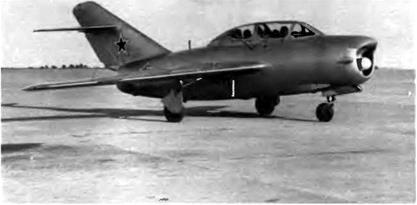UTI MiG-15 /1312 / ST
In the MiG-15 test report the Nil WS experts had pointed to the need for a two-seat training version of the aircraft. Because the MiG-15 was mass-produced for the WS, the PVO, and the VMF, a “jet-flying class" had to be developed for the many pilots who had flown only piston – engine aircraft. Decrees from the council of ministers on 6 April 1949 and the ministry of aircraft production on 13 April ordered the MiG ОКБ to design and construct a UTI (Uchebno-trenirovich istrebityel: formation and training fighter) by 15 May—that is, in just five weeks! Once the test flights were completed, an entire factory would be dedicated to the sole production of the UTI MiG-15.
|
Armament of the prototype and first-series UTI MiG-15s consisted of one NR-23 cannon and one 12.7-mm UBK-E machine gun. |
The aircraft was a straight two-seat modification of the MiG-15 powered by the same RD-45F engine. Both the student in the front seat and the instructor in the rear were in a pressurized cockpit, A reduced armament suite—one machine gun and one cannon—was placed on a removable rack. Both flight stations had fully instrumented panels and first-generation ejection seats (the same as those in the MiG-15). The front-seat instrument panel and equipment were identical to those of the MiG-15 so that the student pilot could become fully acquainted with his environment in preparation for his first solo flight in the single-seater. With the dual controls, the instructor could always control the aircraft and counteract the student’s mistakes. The front canopy was starboard-hinged, and the rear canopy was rearward-hinged; both could be jettisoned in case of emergency. The rear-seat occupant was ejected first.
For gunnery exercises, the first-series UTI MiG-15s had a 23-mm NR-23 cannon with 80 rounds and a 12.7-mm UBK-E machine gun with 150 rounds. Starting with the sixth series, and after tests with the ST-2, the cannon was replaced on the removable rack by an OSP-48 instrument landing system. The student cockpit was equipped with an ASP – IN gunsight. In the front, two armor plates were bolted on frame no. 4—one to protect the crew, and the other to shield the ammunition

boxes and equipment placed on the machine gun rack. The ejection seats were fitted with armored headrests. Two store stations were provided beneath the wing for 50-kg (110-pound) and 100-kg (220-pound) bombs. An S-13 camera gun was added to the upper lip of the engine air intake. Communication equipment included an RSI-6 transceiver, but most UTI MiG-15s were fitted with an RSIU-3 VHF transceiver, an SRO-1 IFF transponder, and an AFA-1M wide-angle camera. From aircraft no. 10444 onward armament was reduced to a single UBK-E 12.7, and the ASP-1 N gunsight was replaced by an ASP-3N; but the fire control and bombing systems were identical to previous versions. All UTI MiG-15s also had electrically operated flare launchers, one for each of four colors: red, green, white, and yellow.
The ST was built in the OKB experimental workshop between March and May 1949, using a MiG-15 airframe built in Kuybyshev factory no. 1. It underwent factory tests from 23 May to 20 August 1949 under the supervision of three pilots: I. T. Ivashchenko, К. K. Kokkina – ki, and A. N. Chernoburov. State acceptance trials took place at the GK Nil VYS from 27 August to 25 September, and mass production was approved. The prototype was sent to a fighter regiment in Kubinka from October 1949 to April 1950, when it returned to the OKB for the adjustments needed to eliminate the shortcomings recorded in operation. On 15 May it passed the final factory tests administered by Chernoburov and S. Amet-Khan of the LII. In a little over a year the prototype made 601 flights—33 in factory tests, 58 in state trials, 502 in a fighter regiment, and 8 more back at the factory.
As early as 1952 there were in practice four UTI MiG-15s in every fighter regiment equipped with MiG-15s. Besides their normal role as
pilot trainers, they were also used to make weather reconnaissance flights and to teach pilots how to fly at night and under adverse weather conditions. To this end, the front cockpit was equipped with a curtain so that pilots could train for blind flying in the daytime. The aircraft was also used to train pilots for dive-bombing and photo reconnaissance missions.
From the outset, MiG-15s equipped with the older ejection seats were not popular: many pilots were afraid to risk serious injury by using the seat in emergencies. After all, most accidents happen when flying near the ground at minimum control speeds or when landing— and in those situations use of the first-generation seats was risky. This fear presented a psychological obstacle that had to be overcome in order to restore the airmen’s confidence. So it was decided that some of the UTI MiG-15s would be used as ejection trainers. Military instructor parachutists went to WS and PVO fighter regiments and demonstrated ejections above each unit airfield. Then they asked for volunteers among the regiment’s pilots. These volunteers were ejected from the aircraft’s rear seat. The seat carried a reduced pyrotechnic charge, but one still powerful enough to catapult the seat—and its contents—above the aircraft’s fin.
The UTI MiG-15 was mass-produced in the USSR, Czechoslovakia, Poland, and China. Czechoslovakia alone built 2,012 of them (referred to as the CS-102). They have been operational for more than thirty years and have trained all MiG-15, MiG-17, and MiG-19 pilots. In the early 1970s nearly all of the UTI MiG-15s still active in the WS and the PVO were handed over to the DOSAAF (the voluntary association for the support of the army, the air force, and the fleet). That kept the two- seaters in the air for a few more years with pilots from various Soviet flying clubs in the cockpit.
Specifications
Span, 10.085 m (33 ft 1 in); overall length, 10.11 m (33 ft 2 in); fuselage length, 8.08 m (26 ft 6.1 in); height, 3.7 m (12 ft 1.7 in); wheel track, 3.81 m (12 ft 6 in); wheel base, 3.175 m (10 ft 5 in); wing area, 20.6 m2 (221.7 sq ft); empty weight, 3,724 kg (8,208 lb); takeoff weight, 4,850 kg (10,690 lb); takeoff weight with two 260-1 (69-US gal) auxiliary tanks, 5,320 kg (11,725 lb); takeoff weight with two 300-1 (79-US gal) auxiliary tanks, 5,400 kg (11,900 lb); fuel, 900 kg (1,984 lb); useful load (fuel, ammunition, crew), 1,588 kg (3,500 lb); wing loading, 235.4-262.1 kg/m2 (48.3-53.7 lb/sq ft); max operating limit load factor, 8.
Performance
Max speed, 1,015 km/h at 3,000 m (548 kt at 9,840 ft); 720 km/h at
13,0 m (389 kt at 42,640 ft); max Mach number, 0.894; climb to
|
The UTI MiG-15P (ST-7) was used to train pilots to operate the RP-1 Izumrud radar. |
3.0 m (9,840 ft) in 1.5 min; to 5,000 m (16,400 ft) in 2.6 min; to
10.0 m (32,800 ft) in 6.8 min; service ceiling, 14,625 m (47,970 ft); landing speed, 172 km/h (93 kt); range, 680 km at 5,000 m (422 mi at 16,400 ft); 950 km at 10,000 m (590 mi at 32,800 ft); range with two 300- 1 (79-US gal) auxiliary tanks, 1,054 km at 5,000 m (655 mi at 16,400 ft), 1,500 km at 10,000 m (930 mi at 32,800 ft); takeoff roll, 510 m (1,675 ft); landing roll, 740 m (2,425 ft).












